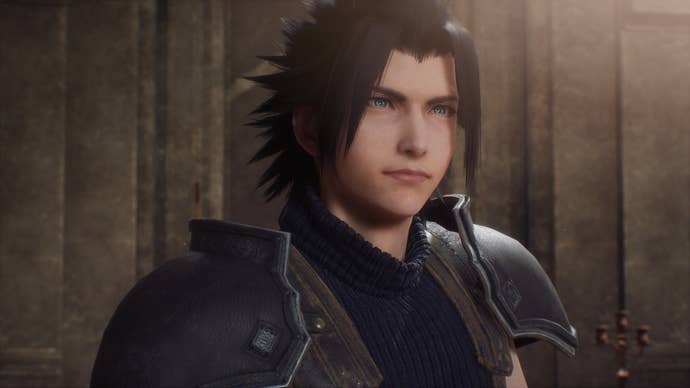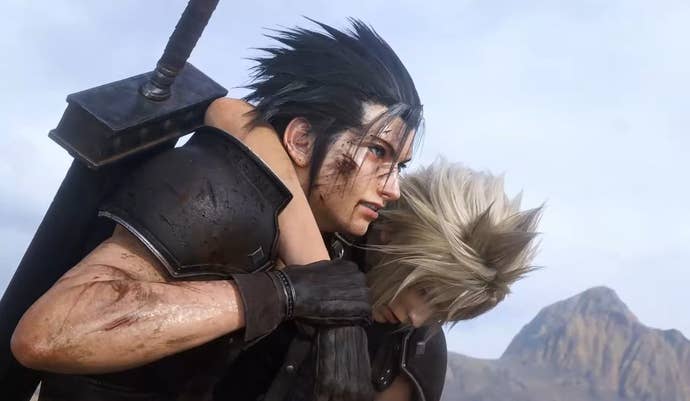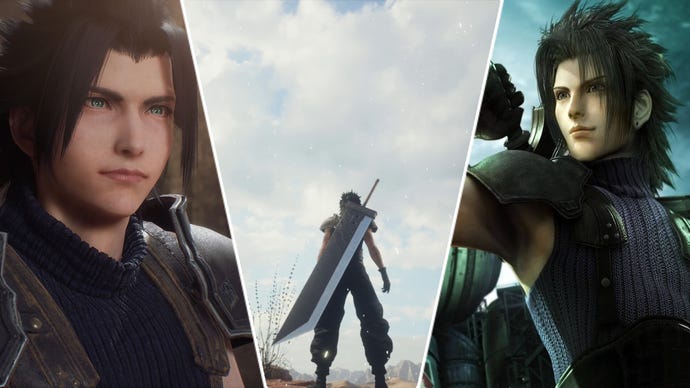PSP game or not, Crisis Core deserves its remaster; it’s become an integral part of Final Fantasy 7
On paper, Crisis Core: Final Fantasy 7 sounds absolutely abhorrent – so how did it become an essential part of the beloved series?
Crisis Core absolutely shouldn’t have worked. By the time it finally released, the rest of the Compilation of Final Fantasy 7 anniversary series had already done everything it could to trample all over the memory of the original game to the extent that you couldn’t help but wonder if you ever really loved it at all.
Dirge of Cerberus was a poor-man’s Gungrave starring the most boring FF7 party member. Advent Children was a garish, incoherent epilogue that softened the original game’s ending and helped push the world further into the more generic anime aesthetic it finds itself in today. After all of that, the proposition of a prequel was downright threatening. A sequel you can ignore, a prequel presents real risk of irreversibly damaging the source material.
On paper, it sounds absolutely abhorrent. A soundtrack of industrial metal remixes? A bizarre slot machine subsystem? A Sephiroth origin story? Confidence in Square Enix’s ability to deliver a Final Fantasy game with real-time combat after Dirge of Cerberus was nonexistent. Admittedly, there were those at the time who strongly felt that it all didn’t work – that it was just another tasteless and superfluous cash-in that needlessly complicated an already bloated saga. Not content with merely fleshing out Zack and Sephiroth’s history, Crisis Core introduces a litany of new characters and secret projects and clone armies and weaves them into the already labyrinthine tapestry of organisations and mad scientists that drove FF7’s story.

Released during what was arguably Square Enix’s flop era, it was easy to see all of this and be immediately turned off. To find out about Sephiroth’s secret best friend based on Japanese pop giant GACKT and die a little inside. To be introduced to a slot-machine based combat system that randomly doles out special abilities and immediately want to go to bed. It all seems a bit gauche. If you can power through some of the flashier excesses of this maximalist era in JRPG history, however, you’ll find a surprisingly sombre and affecting story that strengthens rather than diminishes the original.
Zack is doomed from the opening, which makes his presence as a genuinely light and likeable protagonist in a series famous for gloomy edgelords hit even harder. The finale of the game sees a reimagining of his death. Being shot by three guys on a hill was obviously determined as being nowhere near an epic enough send-off for the overblown anime style of the rest of the Compilation. Instead, Zack valiantly charges headfirst into a battalion of heavily armed troopers and missile-spewing helicopters. Again, it seems like something that should be as ridiculous and gaudy as the rest of the spin-offs. Somehow, it ends up being one of the strongest moments of narrative and mechanical cohesion in Square’s history.

The spinning slots of the absurdly named Digital Mind Wave, which initially came across as a superfluous and silly addition to the combat system, are suddenly used to deliver an emotional gut punch. As the acoustic guitar kicks in and you start slicing into the constantly respawning SHINRA hordes, portraits of the friends Zack has made begin to line up. Memories of them flash before his eyes before burning out like exposed 35mm film. That character’s portrait vanishes, becoming a non-descript silhouette in the slot machine. As Zack takes more hits and his health starts to dwindle, more and more of the people important to him erase themselves from his consciousness.
The music stops, it’s now just down to Zack and those three guys on a hill. You can keep fighting, lurching Zack’s broken body horribly across the battlefield as the screen starts bleeding and the Digital Mind Wave starts breaking down. The only face left on the slots is Aerith, which Zach has been desperately clinging onto as everyone else has faded.
It’s futile, of course – Zack’s fate set in stone by a game released a decade earlier. He eats his last bullet and three portraits of Aerith line up on the screen before being swallowed by light. It shouldn’t work, but it absolutely does. A perfunctory moment from the original is turned into something much grander by utilising the game’s own systems in a way that Square’s games rarely do.

Crisis Core could have been a boring prequel that diligently and methodically got all the pieces neatly in place for the opening of Final Fantasy 7. Instead, it’s an entirely self-contained story of doomed friendships, tragic downfalls, and corporate malfeasance. It uses characters and scenarios players were familiar with to create something genuinely new and surprising. More than a decade later, the “Remake” of Final Fantasy 7 would drastically buck player expectations and strike out in a completely different direction from the original narrative. It’s fair to say that Crisis Core is the smaller experiment that proved that it was possible to tell a new story in the established framework.
It’s important to remember that this will still essentially be a PSP game. If you’ve played the HD remaster of Final Fantasy Type-0 you’ll know to expect that weird gulf between the visual fidelity and the strangling constraints of the environments and encounters. There’s a real danger that new players trying the game on big expensive PCs and modern consoles will hit a wall where the expectation of an unsung classic meets boring corridors and repetitive button mashing. Level and combat design that works perfectly for short bursts on public transport could absolutely whither when dragged onto a bigger screen.

If you can handle all of that, you’ll find the blueprint for the Final Fantasy 7 Remake – a story that uses characters you already care about in a genuinely surprising way that moves beyond just dutifully sticking to what came before. It’s incredibly silly on a visual and mechanic level while being deathly serious, which is remarkably appropriate for being based on a game where you can fight a haunted house inbetween bouts of environmental terrorism.
If you consider the original Final Fantasy 7 a sacred text, Crisis Core will turn your stomach. If you’re not quite so dogmatic, you’ll find a fascinating artefact in one of the most enduring tales in the medium.


